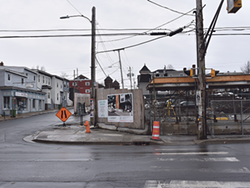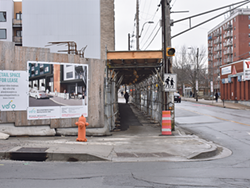
Mitigation of development and construction impacts, the rules surrounding shutting down sidewalks and streets for construction, have been updated to protect pedestrians as the importance of new developments continues to grow across HRM.
The old guidelines allowed construction sites to temporarily close or use only a portion of the street and area adjacent to the site for the public's protection, but they failed to take into account the disruptions that closures cause. The new amendments address shortcomings for local businesses, parking and pedestrians.
"We're very pleased with the steps that have been taken. They were highly overdue and very necessary," said Milena Khazanavicius, a volunteer at Walk'n'Roll and CNIB, who is fully blind and uses a guide dog. "However, for all construction, the primary focus needs to be on pedestrians, whether they are able-bodied or not-able bodied, and their safety, followed by bikes, buses and other traffic."
With the new changes, construction sites that interfere with the sidewalk or the road are now legally required to create "F-type" concrete barriers in order to separate a temporary sidewalk from traffic, as well as provide way-finding signage for pedestrians and cyclists. This change is intended to provide a clear, consistent set of requirements for pedestrian management that allows for efficient and easy navigation around construction sites and to locate nearby businesses. Although signage was required in original documents, there was no specification of size, content or location.
While searching for a solution to the accessibility issues, Khazanavicius, alongside other members of Walk'n'Roll and CNIB, blindfolded engineers and had them interact with the site to better understand their experience. These new changes are reflective of their observations, but Khazanavicius reminds future engineers not to forget about this strategy.
"These changes have been in the making for five years. I used to be called in to see if what was being proposed for the construction site would work. They've completely forgotten to keep doing that," says Khazanavicius. "Whatever safety plan that is put together for pedestrian accessibility, needs to consult with the organizations and the people that they are installing these crosswalks for. It can't just be the engineers."
Downtown businesses owners were also concerned about the impact of construction projects on their operations, calling for HRM to provide compensation to help offset lost income. Although it is impossible for HRM to provide payments for businesses affected by longterm street closures according to the Charter, way-finding to local businesses is permitted, as is increased advertising for the businesses themselves. In addition, the new changes require informative signage directing motorists to alternative parking when spots are removed.
However, there are still some shortcomings to the guidelines. Locations do not have specific requirements for protection around new or existing HRM trees and little is mentioned regarding snow removal obligations. There is also currently no enforcement in effect to penalize construction sites for not following these rules, leaving sites around the municipality free to continue as they are without fear of repercussions.
"It seems to me that anything short of a final penalty or stop-work order isn't going to get the job done or change their behaviour," said District 7 councillor Waye Mason on construction sites violating guidelines at a regional council meeting on February 25. "What has been proposed today is better than what we have now...but I still think that we have work to do."
Editor's note: The print version of this story ran two sets of numbers for the number of women who have run and won in Halifax elections. The numbers in this article are the correct stats based on The Coast's analysis of available data from halifax.ca.
















